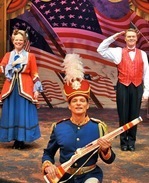SITE GUIDE
SEARCH
REVIEWS
REVIEW ARCHIVES
ADVERTISING AT CURTAINUP
FEATURES
NEWS
Etcetera and
Short Term Listings
LISTINGS
Broadway
Off-Broadway
NYC Restaurants
BOOKS and CDs
OTHER PLACES
Berkshires
London
California
New Jersey
DC
Connecticut
Philadelphia
Elsewhere
QUOTES
TKTS
PLAYWRIGHTS' ALBUMS
LETTERS TO EDITOR
FILM
LINKS
MISCELLANEOUS
Free Updates
Masthead
A CurtainUp Connecticut Review
George M.

Ensemble members performing "Grand Old Flag"
(Photo: John Vecchioll) |
Cohan’s life and music are the subjects of George M currently on stage at the popular dinner/entertainment venue, the Westchester Broadway Theatre in Elmsford, New York. The music had a brief (for Broadway) run in 1968 with Joel Grey in the title role but is too infrequently revived.
The book by Michael Stewart and John and Fran Pascal is a pretty trite rendering of the man’s life, but recalling the chronology of his career and the generous sample ((25 songs) of his prodigious output, goes a long way in explaining his prominent place in the history of the American musical comedy.
Since we’re now well over a century past his era, few theatergoers, and especially younger ones have little awareness of the man. Those of a certain age (myself included) may remember James Cagney’s Oscar-winning role as Cohan in the 1942 film, “Yankee Doodle Dandy” – most others will draw a blank, though his songs are still familiar, easy to sing and just as patriotic.
The Westchester production, directed and choreographed with verve by Richard Stafford (Jonathan Stahl assisted), wisely concentrates on the music and the dancing, basically tap. The script begins and ends on basically the same note. Cohan was a brash, outspoken, egotistical, incredibly talented young man and ends as a brash, outspoken, egotistical, incredibly talented old man. In between there is familiar backstage drama: a failed marriage, battles with producers, resistance to change, the bane of many performers, especially in the vaudeville era, and finally an emotional fadeout. The strum and drang is kept to a thankful minimum and the music to the max.
John Scherer has the title role and though he initially seems a bit old for the young Cohan, he quickly erases any doubts about that with a non-stop, invigorated performance that includes singing at least half of the songs and dancing like a man possessed.
Stafford’s choreography and Scherer’s fancy foot work will convince anyone who thinks that tap is a limited form of dance to change their minds. When the entire ensemble is onstage tapping away, there’s energy to spare.
Cohan’s life centered not just on the stage, but with his family. Father Jerry (Jim Walton), mother Nellie (Melodie Wolford), and sister Josie (Amanda Trusty) with whom he performed as an act from toddler to adult. Whether his parents will retire or Josie leave the act to begin a family is one of the caveats in the Cohan success story. All three performances are well rounded characterizations including the Cohan ability to sing and dance.
Few other characters register significantly in the story. Laura Schutter is fine as Ethel Levey, Cohan’s first wife, who eventually tires of his obsession with the business and Jeanette Minson is warm and comforting as Agnes Nolan the second Mrs. Cohan, who let him have his way.
Whether it was the fault of sound system or just plain loudness, Carol Schuberg as Madame Grimaldi and especially Katharine Heaton as the diva Fay Templeton came off as screeching harpies. The new-show-each-month policy, now in effect at the theater, seems to have limited the scope of the sets, but designer John Farrell has provided sufficient evidence of life in the theater and Leon Dobkowski’s period costumes colorfully fill in any gaps in the artistic spectrum.
You’re not likely to come away with any profound feeling about Cohan as a man but you’re sure as shooting going to come out humming one or more of his classic tunes – and that’s what he had in mind all along.
|
George M Music and lyrics by George M Cohan Book by Michael Stewart and John & Fran Pascal Lyrics and music revisions by Mary Cohan Directed and choreographed by Richard Stafford Associate Director and Choreographer: Jonathan Stahl Cast: John Scherer (George M. Cohan), Jim Walton (Jerry Cohan), Melodie Wolford (Nellie Cohan), Amanda Trusty (Josie Cohan), Jeanette Minson (Agnes Nolan), Laura Schutter (Ethel Levy), Katharine Heaton (Fay Templeton), Gary Lynch (Sam Harris.) Set design: John Farrell Costumes: Leon Dobkowski Musical direction: Leo P. Carusone Lighting design: Andrew Gmoser Sound design: Jonathan Hatton Westchester Broadway Theatre, 1 Broadway Plaza, Elmsford, N.Y. Exit 23 off the Saw Mill Parkway Through July 1st. Performances: Thursdays through Saturdays at 8, Sundays at 7 and matinees Wednesdays and Thursdays at 1 and Sundays at 1:30. Dinner or lunch is served one and a half hours before the performance. Tickets are $52 to $75 plus tax and include meal and show. Beverage service and gratuities not included. Song List: Act I Always Leave Them Laughing Musical Moon Oh You Wonderful Boy All Aboard for Broadway Musical Comedy Man I Was Born in Virginia Twentieth Century Love My Home Town Billie Push Me Along in My Pushcart A Ring to the Name of Rose Popularity Give My Regards to Broadway Act Two: Forty-Five Minutes from Broadway So Long Mary Down by the Erie Canal Mary’s a Grand Old Name All Our Friends Yankee Doodle Dandy Nellie Kelly Harrigan Over There You’re a Grand Old Flag The Man Who Owns Broadway I’d Rather Be Right |

 Book of Mormon -CD
Book of Mormon -CD
